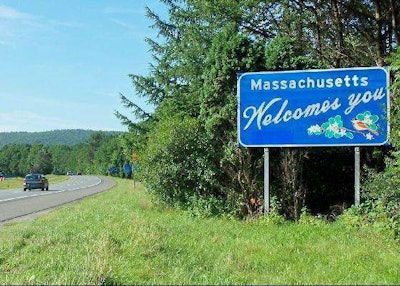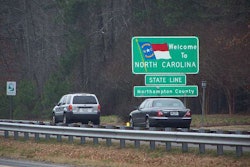 Photo Credit: Flickr user J. Stephen Conn
Photo Credit: Flickr user J. Stephen ConnThe Massachusetts Complete Streets Funding Program has announced grant funding to 11 participating municipalities who will be adopting polices and practices aimed at providing safe and accessible options for all travel modes.
The Complete Streets Funding Program was launched February 1, but was authorized by the 2014 Transportation Bond Bill. To become eligible for construction funds, municipalities must attend an initial program workshop, score 80 or above out of 100 on a Complete Streets Policy and develop a Complete Streets Prioritization Plan.
Municipalities are eligible for up to $50,000 for technical assistance and up to $400,000 for construction funding.
So far this year, 91 municipalities have approved policies and 27 have approved prioritization plans. A total of $12.5 million is available through fiscal years 2016 and 2017
“Massachusetts Department of Transportation (MassDOT) is pleased to partner with municipalities across the Commonwealth to offer the Complete Streets Program to help communities make much needed transportation improvements,” says Transportation Sec. & CEO Stephanie Pollack. “I would like to thank all of the state and local officials, civic and community leaders, and members of the MassDOT staff who have helped to streamline the program, and highlight the need to incorporate ‘complete streets’ into design and planning projects.”
Details on the 11 municipalities announced include:
- Actonwill receive funding for town center pedestrian safety improvements, reconfiguration of travel lanes on Main Street (Route 27) at Maple Street/High Street to improve bicycle safety, and Main Street Corridor Bike Lanes to improve bike safety between the Assabet River Rail Trail and the Bruce Freeman Rail Trails. In addition, the town will also install a sheltered bike rack at the South Acton Commuter Rail Station to serve the large number of cyclists who seek access to the station on a daily basis.
- Arlingtonwill receive funding to make improvements to Gray Street, which serves as a major route for children walking to Ottoson Middle School. The Gray Street Pedestrian Accessibility & Connectivity Improvement Project will provide a new section of sidewalk, new handicap ramps, and improve the safety and visibility of the crosswalk located at Quincy and Fountain Street with a new pedestrian activated beacon. The project will make the major street crossing and path to the school more visible, accessible and safe for children and other pedestrians.
- Beverly will receive funding for the reconstruction of Broadway Street to provide a network for pedestrians and bicyclists to connect Beverly’s downtown commercial district with the Beverly Depot Commuter Rail Station. New ADA compliant sidewalks and curb ramps, bicycle sharrows, signage, and pedestrian scaled lighting will nicely complement MassDOT’s current Rantoul Street improvements.
- Cambridgewill receive funding to enhance major city and Chapter 90 funded projects on Massachusetts Avenue and Lawn Streets. Cambridge’s two roadway segment improvement projects will improve walkability and provide bicycle network accommodations. Cambridge will also improve user safety by providing pedestrian signal timing improvements, marked crosswalks and reducing corner radii to increase intersection crossing safety, and bicycle parking at transit stops. In addition, Complete Streets funding will be used for sidewalks, pedestrian ramps and bike parking.
- Framinghamwill receive funding to build a section of a two-way multi-use path originating just north of the intersection of Fountain Street and Dudley Road and continuing along the east side of Dudley Road, terminating at Dr. Harvey L. Cushing Way. The multi-use path will link residents in nearby neighborhoods to downtown transit, employers, and schools, and provide access to major Town recreation amenities.
- Lawrencewill receive funding to create a safer path to the Wetherbee School and to Riverside Park. Sidewalks will be repaired along Kingston Street to Riverside Park and new crosswalks and ADA compliant ramps at the intersections. The Kingston/Everett intersection will be addressed to calm traffic speed and reduce crossing distance. New flashing beacons will also alert vehicles to crossing pedestrians.
- Lowellwill receive funding to construct a new lighted and landscaped multi‐use shared path in the South Commons Park to provide vital connections between the Gallagher Multi‐Modal Bus/Train Terminal, the Rogers School STEM Academy, and the Markham Village low‐income apartments. Another multi use trail spur will run parallel to Thorndike Street from the Highland Street intersection to the Gallagher Terminal intersection. The improvements dovetail with the new multi‐modal improvements being done as part of the Lord Overpass reconstruction project.
- Medford will receive funding to improve pedestrian safety at six strategic locations, including traffic calming and signal improvements at Brooks Elementary School and intersection and crossing improvements at West Medford Square, Tufts Pool and Park, Medford Square, and Winthrop circle. Funding also supports bicycle safety improvements along Boston Avenue with a northbound separated bicycle lane and southbound shared lane between High Street in West Medford to the Somerville line on Broadway.
- Stoughtonwill receive funding to improve walkability and accessibility of Central Street from the intersection of Pearl Street to the intersection of Tosca Drive. New sidewalks with traffic calming landscaping buffer strips will help to better connect pedestrians to schools and low income housing and recreations facilities. The project serves Environmental Justice populations and also leverages a Safe Routes to School Project and a TIP intersection improvement project at Tosca/Central Street to increase the overall impact.
- Westwood will receive fundingto improve the intersection geometry and crossing safety of High Street and Pond Street. The town identified these areas of need through a safety audit. Approximately 1,000′ of new sidewalk will be constructed on the westerly side of High Street from Millbrook Road to Pond Street to improve connectivity between residential neighborhoods and the William E. Sheehan School. An additional project includes constructing 5‐foot bike lanes in each direction along 1‐mile of Blue Hill Drive to improve local and regional bicycle connectivity from Canton Street to University Avenue and the University Station transit facility and mixed‐use development.
- Winchesterwill receive funding to construct pedestrian safety improvements at twelve critical locations across town. Improvements include traffic calming, (or narrowing travel lanes), improved crosswalks, installation of pedestrian flashing beacons, and installation of “Your Speed” radar feedback signs. Locations include the crosswalk on Highland and Stone Avenue, a primary walking route for children attending the Muraco Elementary School.
More information on the Complete Streets Funding Program is available here.









